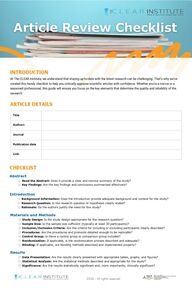
Return to flip book view
Message
IntroductionAt The CLEAR Institute, we understand that staying up-to-date with the latest research can be challenging. That’s why we’vecreated this handy checklist to help you critically appraise scientific articles with confidence. Whether you're a novice or aseasoned professional, this guide will ensure you focus on the key elements that determine the quality and reliability of theresearch.Article detailsTitleAuthorsJournalPublication dateLinkChecklistAbstract Read the Abstract: Does it provide a clear and concise summary of the study? Key Findings: Are the key findings and conclusions summarized effectively?Introduction Background Information: Does the introduction provide adequate background and context for the study? Research Question: Is the research question or hypothesis clearly stated? Rationale: Do the authors justify the need for this study?Materials and Methods Study Design: Is the study design appropriate for the research question? Sample Size: Is the sample size sufficient (typically at least 30 participants)? Inclusion/Exclusion Criteria: Are the criteria for including or excluding participants clearly described? Procedures: Are the procedures and protocols detailed enough to be replicable? Control Group: Is there a control group or comparison group included? Randomization: If applicable, is the randomization process described and adequate? Blinding: If applicable, are blinding methods described and implemented properly?Results Data Presentation: Are the results clearly presented with appropriate tables, graphs, and figures? Statistical Analysis: Are the statistical methods described and appropriate for the study? Significance: Are the results statistically significant and, more importantly, clinically significant?2024 - All rights reserved
Additional Tips Beware of Percentages: Understand the actual measures behind percentage improvements. Small absolutedifferences may not be clinically significant. Context Matters: Laboratory conditions differ from clinical practice. Be mindful of how study conditions mightaffect real-world application. Ask Questions: When presented with “facts,” always ask “Compared to what?” and seek out independentstudies to verify claims.ConclusionBy following "The CLEAR Institute Article Review Checklist" you can ensure that you are critically evaluating thescientific literature and making informed decisions for your practice. Stay curious, stay informed, and keep making themove with The CLEAR Institute!Discussion Interpretation: Do the authors provide a reasonable interpretation of the results? Comparison: Are the results compared with findings from previous studies? Limitations: Do the authors acknowledge the limitations of their study? Future Research: Are suggestions for future research provided?Conclusion Summary: Does the conclusion succinctly summarize the main findings and their implications? Bias and Conflicts: Are potential biases and conflicts of interest disclosed? Funding: Is the funding source stated, and is there any potential for bias?Overall Credibility Peer-Reviewed: Is the article published in a peer-reviewed journal? Independence: Are the findings presented independent and free from commercial influence? Transparency: Are all aspects of the study, from design to results, transparently reported?Special Offer: Don’t forget to use code FREETRIALMEMBERSHIP for a free 30-day trial of our CLEAR membership,including access to exclusive content, monthly article reviews, and more (limited time offer). Follow this link to viewmore and to register: MORE INFO2024 - All rights reserved